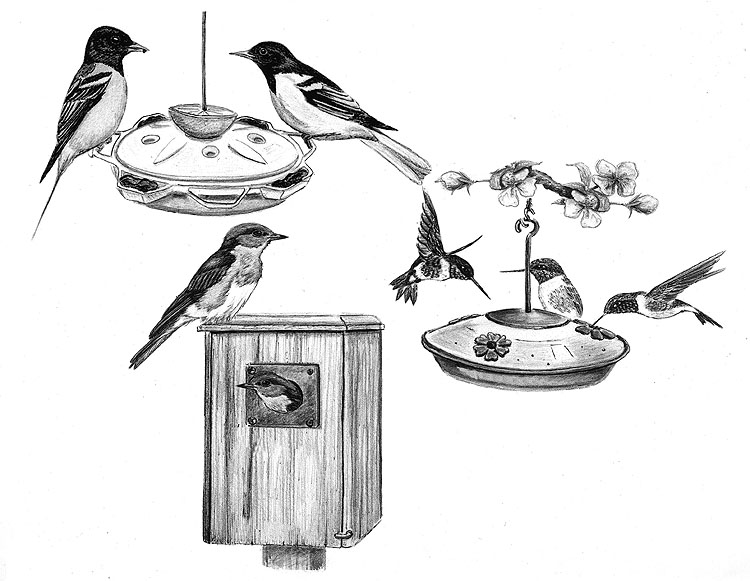
Here come the birds:
With almost everyone homebound right now, I think we all could stand a little good news, and I think I have some. The birds are coming. Luckily for us, birds don’t watch cable news so they aren’t constantly bombarded with menacing headlines. The only things on their minds right now are finding a mate, building a nest and raising a family. They let us worry about everything else. Perhaps it’s time we shut off the hysteria for a while and spend a day or two watching the birds in our own yards because they are coming back…today.
While the rest of us are showering with bleach and renting safe deposit boxes to stash supplies of toilet paper, tiny Ruby-throated Hummingbirds have been working their way north from Central America. Arriving in the U.S. in early March, and averaging roughly twenty miles per day (like a retiree in a Winnebago), the hummers are on the move and will be arriving here this week, and I for one will be glad to see them. It’s time to get our hummingbird feeders out, or at least start looking for them. Check the basement, garage or behind the toilet paper in your safe deposit box. Amazingly, the birds will remember exactly where they saw your feeder last year, even if you don’t. And in case you have forgotten the food formula as well, it’s four parts water to one part sugar. I repeat those numbers so often I’ve made them my bank account password. Don’t tell anybody.
Here’s a question: A week or so after the hummers arrive, what bird comes next? That’s right, the Baltimore Orioles are also on the way. Those bright orange birds, which seem to be out of place in New England, will also soon be here and they’ll be hungry. Orange halves, a sugar-water feeder or a dish of grape jelly are what we can offer them. The female oriole will also be searching for something else, too: nesting material. Each spring I take short six-inch pieces of string or yarn and hang them on tree branches. Mrs. Oriole will quickly snap them up and weave them into her pouch-shaped nest. Caution: Avoid using long pieces of string (the birds can get themselves tangled in them) or plastic, especially loose strands from those blue or green tarps we all seem to have. The birds readily grab the polyester fibers, but the slippery strands don’t hold together well and the nest can fall apart at the worst possible time. Then you’ll have to deal with the birds’ lawyers, and Baltimore lawyers are tough.
Speaking of nesting: Every fall, customers tell me that they’ve discovered an old nest in one of their birdhouses. Next, they want me to tell them what bird built the nest. I look back at them and say, “Why are you asking me? It’s your birdhouse. That’s like asking me who has been sleeping in your guest bedroom.” (I would never make a good diplomat.) People say they don’t have time to stare at their birdhouses all day. Well, now we do. Staring at a birdhouse might be the most exciting thing we get to do all spring. I find it fun to watch House Wrens fly back and forth with twig after twig after twig. Tree Swallows love white feathers and will often fight over them like humans fight over rolls of toilet paper. (Okay, no more toilet paper jokes, maybe.) If any of your friends have pet chickens or ducks, ask them to save the white feathers for you. You can actually toss a feather into the air, like tossing a tennis ball to a dog, and the birds will swoop down and grab them (the feathers, not the ball or the dog).
While this is never the case in my yard, many nest boxes are filled with bluebird eggs right now and soon those same boxes will contain hungry baby birds. Young bluebirds are fed a steady diet of insect larva, crickets and grasshoppers. But the harried adults will also come to a cup filled with mealworms. They’ll take dried or live worms, but mostly live. Watching adult birds feeding their babies is quite a thrill. I’ll admit feeding bluebirds might not be as exciting as the trip you were planning to Paris this spring, but who wants to see the Mona Lisa while she is wearing a face mask?
Lots of people have trouble identifying birdcalls. When they ask for advice, I tell them to just locate the bird that’s doing the singing. That sounds like a flippant response, but it’s based on my own experiences. When I actually see the singer in action, I remember it better. People tell me they don’t have time to search for the singing bird. Once again, we do right now. With most everyone in shutdown mode, we have all kinds of time to walk around the backyard searching for the mysterious singer. FYI: the mysterious singer should not be confused with TV’s Masked Singer, which is somehow even more disturbing than those cable news headlines.
With the theaters dark, sporting events canceled and TV showing giant singing rabbits, our entertainment options are rather limited. This might be the year to learn the calls of your local birds, identify the occupants in your birdhouses and appreciate the returning birds of summer. The hummingbirds, orioles, swallows and catbirds (Whoa! I almost forgot about the catbirds) are all on their way and they are looking forward to seeing us…or at least seeing the stuff we have put out for them. Birds have minimal requirements and unsurprisingly, there is definitely one thing they don’t need… you guessed it, toilet paper. Birds are lucky.